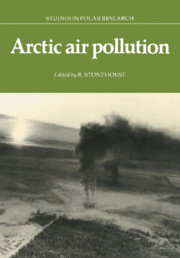Book contents
- Frontmatter
- Contents
- CONTRIBUTORS TO THIS VOLUME
- FOREWORD
- INTRODUCTION: INTERNATIONAL SYMPOSIUM ON ARCTIC AIR POLLUTION
- Part 1 Composition, source areas and transport pathways
- Part 2 Local, regional, global, ecological and climatic implications
- Part 3 Health and ecological issues
- Epidemiology of health effects of air pollution
- Biological effects of low-level ionizing and non-ionizing radiation
- Ecological processes in the cycling of radionuclides within Arctic ecosystems
- Cancer incidence and risk in Alaskan natives exposed to radioactive fallout
- Indoor air pollution and public health concerns
- Exposure to heavy metals in Greenland from natural and man-made sources
- Ecological implications of arctic air pollution
- Part 4 International cooperation and state responsibility
- 5 Conclusions
- Index
Epidemiology of health effects of air pollution
Published online by Cambridge University Press: 03 May 2010
- Frontmatter
- Contents
- CONTRIBUTORS TO THIS VOLUME
- FOREWORD
- INTRODUCTION: INTERNATIONAL SYMPOSIUM ON ARCTIC AIR POLLUTION
- Part 1 Composition, source areas and transport pathways
- Part 2 Local, regional, global, ecological and climatic implications
- Part 3 Health and ecological issues
- Epidemiology of health effects of air pollution
- Biological effects of low-level ionizing and non-ionizing radiation
- Ecological processes in the cycling of radionuclides within Arctic ecosystems
- Cancer incidence and risk in Alaskan natives exposed to radioactive fallout
- Indoor air pollution and public health concerns
- Exposure to heavy metals in Greenland from natural and man-made sources
- Ecological implications of arctic air pollution
- Part 4 International cooperation and state responsibility
- 5 Conclusions
- Index
Summary
This contribution was invited because I recently served on a National Research Council Committee which considered and wrote a report on the Epidemiology of Air Pollution. The report was to be released on September 1 1985, and I intended to discuss its conclusions and apply them to the problem before us. The report had not been officially released, so I spoke instead about issues discussed during the committee's deliberations that were likely to be of interest to this group, and are pertinent to future studies in Alaska.
This group is addressing one of the most important issues debated by that National Research Council Committee: is today's ambient air pollution damaging human health, and will ambient pollution be more or less harmful in the future? The role of epidemiology in getting answers to those questions was equally important to us and may be important for those in this conference who will act upon one or more of our recommendatons.
We asked ourselves at the outset whether one comprehensive longitudinal study could be designed to answer the most important health effects questions. The answer was an emphatic ‘no’. There was an equally emphatic ‘no’ to the question of a study or studies to establish safety. Evidence of safety is not just the converse of evidence of risk, and safety is much harder to demonstrate than risk. Whatever the size and rigor of population studies with negative results, they are virtually useless in assuring safety in other populations and circumstances.
- Type
- Chapter
- Information
- Arctic Air Pollution , pp. 201 - 206Publisher: Cambridge University PressPrint publication year: 1987

